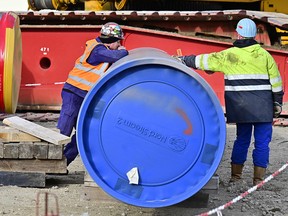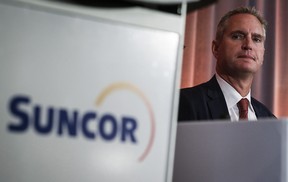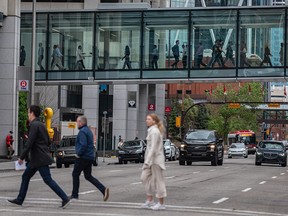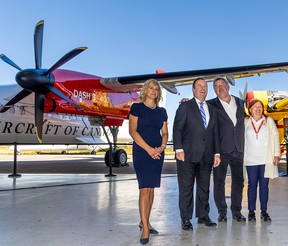
Albertans don’t need many reminders of what became the most important business story of 2022.
It confronts them every time they go to the pumps, stroll through a grocery store or open their utility bills.
Inflation — and its tag-team partner, soaring interest rates — jumped to the forefront as the most influential economic concern of the year.
“It’s No. 1, just because it’s impacting everyone,” says Alberta Central chief economist Charles St-Arnaud. “Rising inflation and rising interest rates — it’s hard to escape it.”
As 2022 winds down, it’s time to look back at the top 10 business stories of the year in Alberta.
There were no shortages of high-impact events: soaring energy prices and record oilpatch profits; the province returning to a supersized surplus; and the end of vaccination passports.
Yet, inflation was a constant concern.
The reverberations of the pandemic, which caused supply chain disruptions, were already becoming acute problems in 2021.
Russia’s invasion of Ukraine in February sent energy prices into the stratosphere.
In Alberta, the annual inflation rate sat at 4.8 per cent in January, but jumped up to 8.4 per cent in June, before slowing in November to 6.6 per cent.
In turn, the Bank of Canada cranked up the interest rate dial. Its benchmark overnight rate jumped from 0.25 per cent in February to end the year at 4.25 per cent, capping a painful period of higher debt-servicing costs for businesses and consumers.
A survey of business operators in the summer by the Alberta Chambers of Commerce pegged inflation as their top concern.
Facing pressure to act, the province lifted its 13-cent-a-litre tax on gasoline and provided rebates for sizzling electricity bills. A relief package introduced by the UCP government in November is expected to cost $2.8 billion over three years.
Scorching energy prices provided kindling to the inflationary fire. Benchmark U.S. oil prices started the year at US$75 a barrel and topped $120 in March — and again in June — before returning to the mid-70s by December.
The spark in prices came after the invasion of Ukraine by Russia, the world’s largest oil and gas exporter, reviving global concerns about security of supply.

A surge in oil and gas prices triggered an energy crisis in Europe. It catapulted profits upward for petroleum producers around the world.
ARC Energy Research Institute pegs Canadian oil and gas sector revenues will reach a record $228 billion in 2022, a 51 per cent increase from last year.
“We have gone to a place where energy security is, once again, top of mind,” says Calgary Chamber of Commerce CEO Deborah Yedlin.
“From an energy standpoint, it means you have oilpatch profits, you have money being returned to shareholders, you have oilsands companies reaching payout, and it all contributes to the provincial coffers.”
The S&P/TSX Capped Energy Index climbed 42 per cent between January and late December.
“I’ve never seen the sector in such good shape as it is now,” says Martin Pelletier, senior portfolio manager at Wellington-Altus Private Counsel in Calgary.
“They didn’t spend as if oil was at $100 . . . It certainly resulted in some healthy and strong gains this year.”
While energy sector fortunes improved, the rapid turnaround in Alberta’s financial picture was equally breathtaking.
After posting a miserable $17-billion deficit in 2020, the province reported an unexpected $3.9-billion surplus for 2021-22 — the first since 2014 — based on crude prices averaging US$77 a barrel
The surprising surplus has mushroomed into a projected $12.3-billion behemoth for the current fiscal year ending next March. Resource revenues, which barely broke through $3 billion two years ago, are expected to hit a record $28 billion.
The province has room to spend billions of dollars on affordability measures, inject money into the Heritage Fund and pay off more than $13 billion of debt this year.
There were also several intriguing corporate stories in the province this year, and the saga surrounding Suncor Energy was one of the most surprising.
The venerable integrated oil producer, after several years of disappointing results, found itself under the microscope in April.
High-profile activist investor Elliott Investment Management, with a track record of success, called for changes at the company, including the sale of the Petro-Canada retail chain, which Suncor’s board examined and later rejected.
It also demanded an overhaul of Suncor’s operational and safety culture, citing a number of fatal incidents involving employees and contractors.

Suncor CEO Mark Little left the company in July, one day after a fatality at Suncor’s base plant mine. The company reached an accord with Elliott, agreeing to add three new independent board directors.
As oilpatch profits ballooned, the industry felt the heat as the federal government proceeded with plans to cap industry emissions.
Ottawa signalled it wants the sector to slash its emissions by 42 per cent by 2030, from 2019 levels.
Companies such as Cenovus Energy, the UCP government and industry groups contend reaching the aggressive federal target by the end of this decade isn’t feasible.
Major oilsands producers, working together to reach net zero by 2050, plan to curb their emissions by about 27 per cent by the end of this decade.
“I’m very worried that if we remain on this path, it could lead to shutting in production at a time when the world is literally crying out for more oil and gas production,” Cenovus Energy CEO Alex Pourbaix said in July.
It didn’t take long for the emissions cap and other federal-provincial scraps to filter into the UCP leadership campaign to replace Jason Kenney as premier.
During the summer, former Wildrose Party leader Danielle Smith vowed to introduce an Alberta sovereignty act if she won the race; Smith did, and her government passed the act during her first sitting in the legislature as premier.
The act authorizes the province to refuse to enforce federal laws or programs the legislature deems unconstitutional or would negatively affect Alberta’s interests.
While the legislation was a toned-down version of what many had expected, it triggered a spirited debate within the business community.
Some argued Alberta must stand up to federal intrusion of provincial jurisdiction; others, including the Calgary and Canadian chambers of commerce, argued it would create uncertainty and could drive investment out of Alberta.
For many businesses pounded by the prolonged pandemic, including the tourism sector, the end of the mandatory vaccination passport program and public health restrictions in February signalled a recovery was finally nearing.
The province also lifted work-from-home requirements, sparking a partial return to downtown offices on March 1.

“From a business standpoint, to be open and not be constrained in any way was huge,” says Yedlin.
Pandemic measures ceased in 2022, yet there often seemed to be no end in sight for one of the longest-running stories — the federal Competition Bureau’s efforts to block the takeover of Calgary-based Shaw Communications by Rogers Communications.
The $26-billion deal was first announced in March 2021, but faced bureau opposition.
In June, Rogers and Shaw agreed to sell Shaw’s Freedom Mobile wireless unit to Quebecor Inc. subsidiary Videotron for $2.85 billion, although the bureau argued it wouldn’t adequately offset reduced competition from the corporate union.
It led to hearings before the Competition Tribunal in November, which lasted into mid-December.
The tribunal issued a notice late Thursday that it had determined the merger was not likely to result in higher prices for wireless customers in Western Canada, and that it was satisfied the plan to sell Freedom Mobile to Videotron was adequate to ensure competition isn’t substantially reduced.
The decision clears a path for the deal to go ahead, requiring only approval from federal Industry Minister Francois-Philippe Champagne.
As Alberta’s economy rebounded and diversified, one of the most significant steps came from the aviation industry.

In September, De Havilland Aircraft of Canada — which moved its headquarters to Calgary from Toronto earlier in the year — unveiled plans to build a manufacturing complex and aerodrome east of the city.
The complex is expected to house up to 1,500 workers and will include a runway, aircraft assembly facilities, parts manufacturing and distribution centres, and maintenance repair operations.
Meanwhile, Calgary-based WestJet repositioned itself to focus more on its home turf, while also agreeing in March to buy Sunwing Vacations and Sunwing Airlines.
It was the first significant step announced by WestJet’s new CEO, Alexis von Hoensbroech. In the summer, he also said WestJet would shift resources and grow its network in Western Canada.
Chris Varcoe is a Calgary Herald columnist.
You can read more of the news on source
